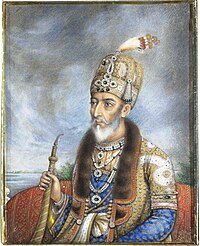Mugal Emperor
| Badshah of Hindustan | |
|---|---|
|
Imperial
|
|

Bahaddur Shah II
|
|
| Details | |
| Style | His Imperial Majesty |
| First monarch | Babur |
| Last monarch | Bahadur Shah II |
| Formation | 30 April 1526 |
| Abolition | 14 September 1857 |
| Residence | Red Fort |
| Appointer | Hereditary |
| Pretender(s) | Javaid Jah Bahadur |
The Mughal emperors, from the early 16th century to the early 18th century, built and ruled the Mughal Empire on the Indian subcontinent, mainly corresponding to the modern countries of Bangladesh, India and Pakistan. The Mughals were a branch of the Timurid dynasty. Their power rapidly dwindled during the 18th century and the last of the emperors was deposed in 1857, with the establishment of the British Raj. The dynasty had Turco-Mongol roots from a Central Asian area now part of modern-day Uzbekistan, and the emperors claimed direct descent from both Timur (generally known in the West as Tamerlane the Great) and Genghis Khan, through his son Chagatai Khan.
The Mughals had significant Indian Rajput and Persian ancestry through marriage alliances, as emperors were born to Rajput and Persian princesses. Only the first two Mughal emperors, Babur and Humayun, were fully Central Asian, whereas Akbar was half-Persian, Jahangir was half-Rajput and quarter-Persian, and Shah Jahan was three-quarters Rajput.
At their empire's greatest extent in the late 17th and early 18th centuries, they controlled much of the Indian subcontinent, extending from Bengal in the east to Kabul and Sindh in the west, Kashmir in the north to the Kaveri basin in the south. Its population at the time has been estimated as between 110 and 150 million (a quarter of the world's population), over a territory of more than 3.2 million square kilometres (1.2 million square miles).
...
Wikipedia
